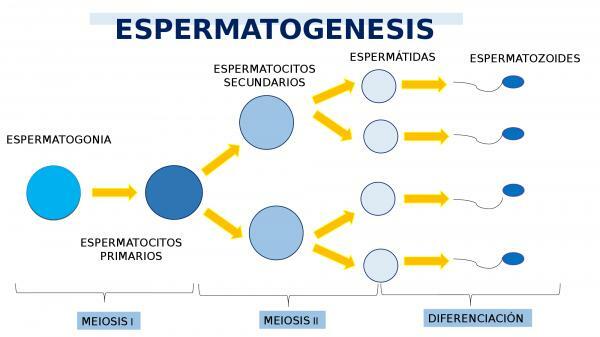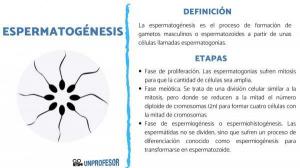What is SPERMATOGENESIS and its stages

The spermatogenesis is the process of formation of male gametes or spermatozoa in man, from mitotically active germ cells or spermatogonia. It takes place at puberty and lasts between 64 and 72 days. Do you want to know more about what is spermatogenesis and its stages? Join us as we tell you about it in this lesson from a PROFESSOR.
Index
- What is spermatogenesis? Easy definition
- Stages of spermatogenesis
- More information on spermatogenesis
- Bibliographic references
What is spermatogenesis? Easy definition.
As we said, the spermatogenesis is he training process from male gametes or spermfrom cells called spermatogonia.
This process takes place in structures of the testicles what are called seminiferous tubules and host the spermatogonia. These tubules also house cells that are essential for this process, such as the Leydig cells (testosterone secreting) and Sertoli cells (hormone-secreting support and nutrition cells).
This process takes place during puberty,
it is when the tubules are already differentiated, although at the time of birth they already host primordial germ cells, although they are still immature structures. The duration of this process is estimated to be between 64 and 72 days and is highly hormonally controlled, being at a higher level controlled by the secretion of GNRH (Gonadotropin Releasing Hormone) by the hypothalamus, causing the pituitary to release LH (Luteinizing Hormone) and FSH (Follicle Stimulating Hormone).In turn, LH influences Leydig cells to secrete testosterone and FSH, on the sertoli cells, regulating intratubular secretion, stimulating spermatogenesis, the synthesis of the androgen transporter protein and inhibin protein.

Image: Outline
Stages of spermatogenesis.
Spermatogenesis can be divided into the following phases (although different authors may use another classification). Thus, the different stages of spermatogenesis are as follows.
Proliferation phase
Spermatogonia suffer mitosis for what the number of cells is large. This phase begins with pale type A spermatogonia dividing by mitosis to give rise to more type A spermatogonia. pale and two type B spermatogonia, which are those that by mitosis will give rise to the primary spermatocytes and will follow all the process.
In addition, there are some dark type A spermatogonia that are like a kind of stem cells from spermatogonia or reserve cells that only divide when there is a drastic reduction in the number of spermatogonia. All these cells still have the diploid chromosome set (2n), that is, 46 chromosomes.
Meiotic phase
The meiosis It is a cellular division similar to mitosis, but where the diploid number of chromosomes (2n) is halved to form four cells with half the chromosomes as the original, or haploid endowment (n). They consist of two divisions:
- Meiosis I: It is suffered by the primary spermatocytes (2n) to give two secondary spermatocytes, with the haploid set of chromosomes (n = 23). It is the reductional division of meiosis proper.
- Meiosis II: It is suffered by secondary spermatocytes (n) to give two spermatids (n). It is practically the same as a normal mitosis.
Spermiogenesis or spermiohistogenesis phase
Spermatids do not divide, but undergo a differentiation process known as spermiogenesis to transform into sperm. These changes consist of:
- Core reduction and condensation
- Elongation with head and tail formation
- Detachment of part of the cytoplasm and completion of cytokinesis, which is the process in which the cytoplasm of new cells formed during nuclear divisions divides. The detachment of part of the cytoplasm generates residual bodies that are phagocytosed (swallowed and digested) by the Sertoli cells
- Cluster of mitochondria in the first portion of the tail. These mitochondria will be necessary to generate the energy necessary for the movement of the tail.
- Formation of the acrosome around the vertex of the head: it is like a cap that derives from the Golgi apparatus and which contains the enzymes necessary to penetrate the layers that surround the nucleus of the ovum during fertilization.
More information on spermatogenesis.
The reason why germ cells undergo a special division that reduces their number of chromosomes to 23, instead of the 46 typical of mitosis, is that by joining the male and female gamete during fertilization, chromosome number is restored normal of the human species, 46. If this process were not the case, humans would double our number of chromosomes in each division, which would be a completely unviable phenomenon for life.
The second thing to keep in mind is that the sperm that finish the process and leave the wall of the tubule seminiferous through contractile movements of the tail, towards the lumen of the tubule, they pass to the epididymis where they acquire their mobility complete. Nevertheless, do not yet have the ability to fertilize an egg, they also undergo a process called training on their journey through the female reproductive tract.

Bibliographic references.
Ross, M. H., & Pawlina, W. (2013). Histology: Text and color atlas with cellular and molecular biology (6th. ed.). Buenos Aires: Panamerican Medical.
If you want to read more articles similar to What is spermatogenesis and its stages, we recommend that you enter our category of biology.

![ORGANS of the circulatory system and their FUNCTIONS [with images]](/f/4e8868df816b5be4b60d7c674887f607.jpg?width=300&height=200)

